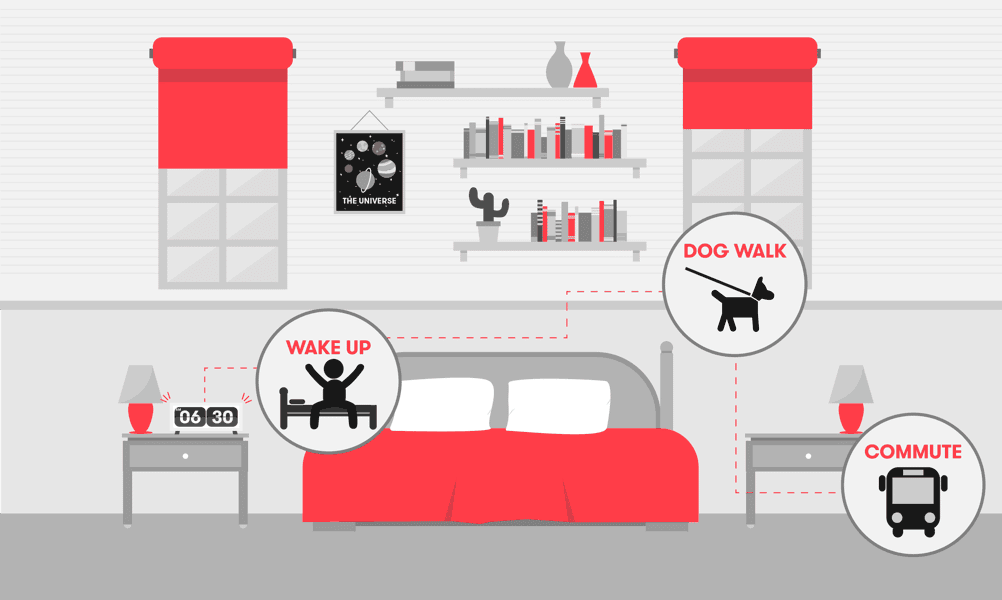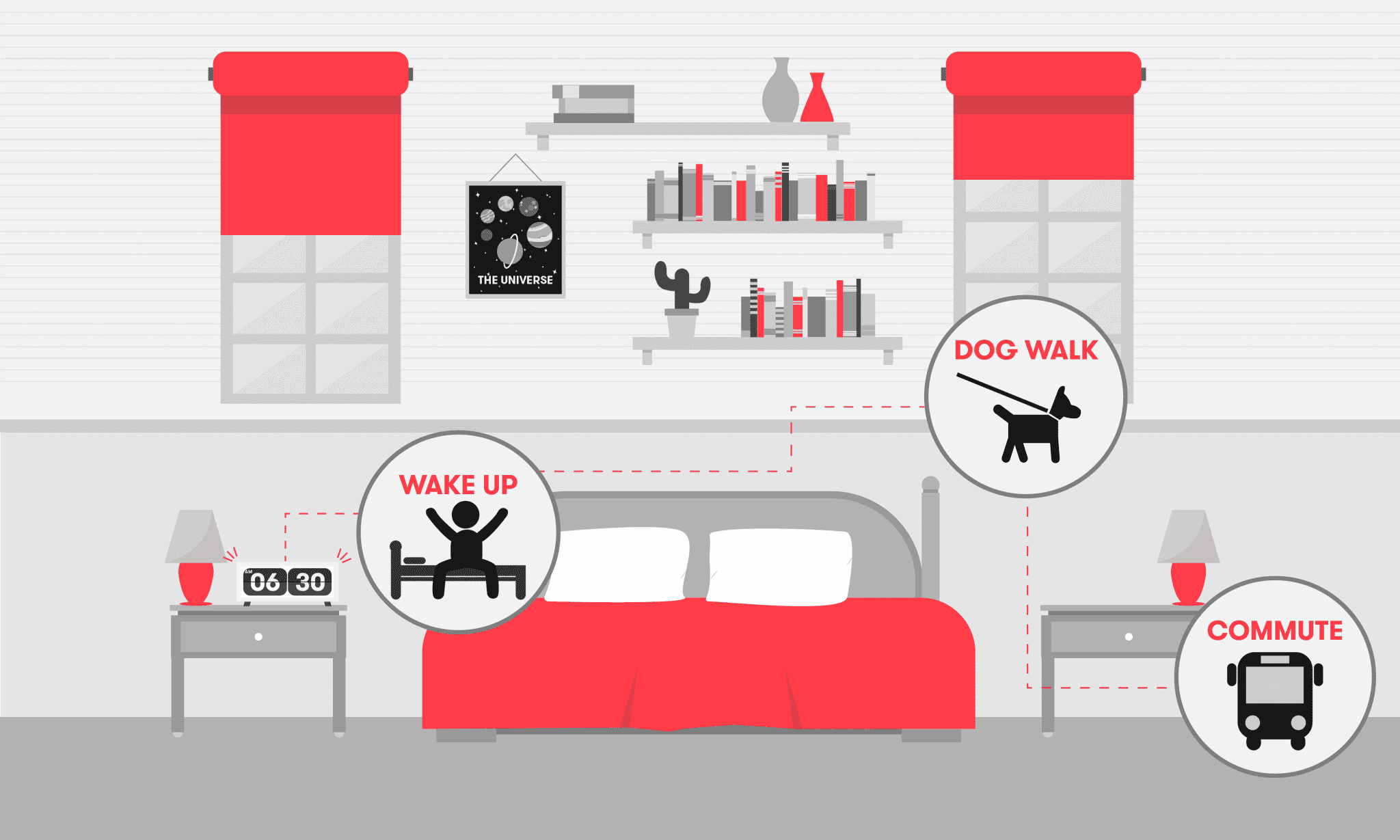
Semantics of time
Targeting your users in the right context also means engaging them at the right time and moment (semantics of time). While some interactions make sense during a user’s morning routine, others will have higher relevance over lunch or during the evening.
Time defines context as different parts of the day trigger different needs and wants. However, time is not absolute. At Sentiance, we strongly believe that the concept of ‘time’ should be personalized. One person’s morning routine might differ from another, depending on the individual lifestyle profile and general habits.
A young parent with a long commute might get up earlier than a single retiree that is well in his seventies. Thus, if we want to target people ‘in the morning’, we need to be able to define an individual timeline for each individual.
Our platform automatically learns to divide a day schedule into blocks of personalized semantic time, both for working days and non-working days. In this post, we investigate if this kind of hyper-personalization is indeed useful, by looking at how semantic time correlates with work and lifestyle.
Note that our machine learning platform automatically assigns a set of user lifestyle and behavioral profiles (aka segments) to each individual person without ever asking for explicit input. Everything is learned from analyzing smartphone sensor data, collected through our mobile SDK.
Are you an early bird or a night owl?
One of the most obvious time-related profiles, is the ‘early bird’ segment. Early birds are people who are up early and tend to be on the road before 07:30 AM. One could wonder how the semantic day schedule differs between working early birds, working late birds, jobless early birds, and jobless late birds.


When visualizing the average semantic day for each of these user segments, we can draw the following conclusions:
- Early birds need their sleep as much as late birds so they typically go to bed at least 2h earlier.
- While early birds tend to start their day around the same time regardless of work profile, working early birds put in a little more sleep as their jobless counterparts.
- It’s interesting to note that working people have a fairly predictable lunch break between 1&2pm, whereas people without a job tend to follow their biorhythm: early birds seem to start their lunch about two hours earlier than late birds.
- Another significant difference is the morning commute. Late birds start their commute to work about 3h later than the early ones.
Let’s get physical
Very often, there is a strong correlation between the time someone gets out of bed, and the amount of physical activity he or she performs during the day. With physical activity we refer to walking, biking, and sport activities. Below, we visualized the semantic timeline of people that fall in our ‘high physical activity’ segment versus the semantic days of people in our ‘moderate physical activity’ segment.

From these timelines we can draw the following conclusions:
- Physical activity is time demanding so ‘highly physical’ profiles tend to start their day earlier.
- The biggest impact is seen with people without jobs: non-working users with low physical activity seem to wake up more than 1.5h later than their active counterparts.
- Lunch routine however does not seem to be impacted by the amount of healthy physical activity.


Sleep is for the weak
A complaint often heard by young parents is sleep deprivation, so we decided to see if this complaint is valid. The following is a visualization of the daily semantic timelines of parents compared to people without kids.

Again people were profiled as parents automatically by our machine learning platform, so no manual user input was needed.
Based on this visualization we can conclude that on average, parents seem to have a day schedule that is shifted a little more towards the early hours. They tend to get up about 20 minutes earlier than people without children, but also go to sleep about 15 minutes earlier.
However, if we only look at parents without jobs, we can take away the bias caused by working hours. This is shown below:

We now clearly see that the effect of having children is larger than what appeared from examining the total population. Having children causes users to get up more than an hour earlier, while people with children only go to sleep about half an hour earlier than users without children. So yes, having kids eats away from your much-needed sleep.
Dogs need their walk around the block
While mining our data to find the reason that people tend to have different semantic times, another interesting case came up. The following visualization shows the semantic day schedule of users who own a dog, versus users who don’t own a dog.

People who own a dog have a semantic morning that starts about an hour earlier than users without a dog. Because of that, also their semantic night starts earlier on average.
Nevertheless, the last activity of the day is later for dog owners than for other users, likely because dog owners tend to take their dog for a walk around the block before they go to sleep.
Commute distance matters
More than work, it is the commute to work which impacts the daily schedule the most. The following graph plots commute distance versus the start of the semantic morning (wake-up time):

We clearly see that a longer commute generally forces people to wake up earlier resulting in shorter nights.
Conclusion
When you contextualize time it becomes personal. Semantic time reflects the individual profile and behavioral patterns of people and allows us to get highly personalized insights into their daily schedule.
If you send out a medication reminder in the morning following the “normal” concept of time, you might get it right for half of the people you’re addressing but you’ll be missing all the late birds who aren’t up as early.
While “normal” time-based targeting might still be the most widely used, we can clearly see it is not the most effective nor reliable basis for interacting with people. Sentiance aims at bridging this by offering an ambient intelligence platform that learns your semantic time, behavior and context and allows for context-aware assistance.


